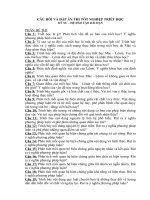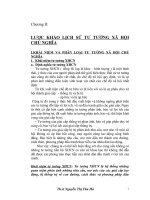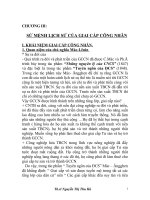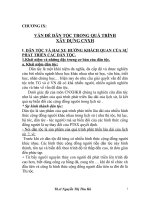Dictation Drawing.doc
Bạn đang xem bản rút gọn của tài liệu. Xem và tải ngay bản đầy đủ của tài liệu tại đây (50.75 KB, 2 trang )
Dictation Drawing
Brian Grover
Students won't listen to what you say in English? Students refuse to speak in the target
language? Have you ever tried a dictation drawing? This is a good listening exercise that
can be used as a warm up for descriptions. I usually get my students to draw my cat (who
has three ears, plaid fur, wears glasses etc. etc. ad absurdium.) The innate competitiveness
of most students impels them to listen very closely and do a bang up job of creatively
rendering the verbal description.
Follow your dictation drawing up with an art show (pre-teach the necessary comparatives
and superlatives and so on.) Narrow the finalists down through small group committees and
then judge the finalists as a whole class.
Rather than an art show place the students in pairs and get them to repeat the procedure,
taking turns rendering a funny face. For the thrill of the moment at least they'll complete it
in English.
Dictation drawing is a great activity; the fun of it all motivates even the most obdurate
students. Bad habits die hard however and are best dealt with from the start. Be tough with
the students. Don't speak to them in their native language. Speak normal speed and only
once until the students ask you [correctly] to slow down and repeat. Pre-teach these and
other such phrases (should be part of lesson number one) and leave them on the board for a
time. When students don't correctly use them just point to the phrases and wait them out.
Most students are very uncomfortable with a sudden hush. They will give you a correct
response (with a little help from their friends.) Gradually --over a period of days -- erase
parts of the target phrases until they disappear altogether.
There should be zero L1 in the classroom. With only one exception: Students can ask you
"What does ____ mean?" "How do you say ____ in English?" But don't translate for them,
engage them in meaningful dialogue. Say, "Gee, I'm not sure." [Even if you are!] "Is that a
____"; "Could you give me an example...?" etc. Keep it up until the meaning has been
worked out IN ENGLISH. Don't worry about wasting the other students' time: they will be
all ears---English ears. When you are speaking in L1 for the sake of efficiency, then worry
about wasting the students' time because that is exactly what you are doing. In an EFL
situation, this kind of student- teacher exchange may be the only chance they have of ever
communicating directly with a native speaker.
If L1 is used students will become conditioned to endure L2 explanations (i.e. snooze)
while waiting for the inevitable translation.
Students will come to regard L2 use (if they use it at all) as part of some kind of silly game
but certainly not for REAL communication. After all didn't their teacher demonstrate to
them on a daily basis that L1 is what is used for the true grit of conveying ideas.
The very act of using L2 for explanations on the other hand gives students a mini-listening
lesson (with full attention) every time meanings are clarified. They not only get the idea
[not always] being conveyed they also get exposure to the rhythms, stress, intonations of
the target language. They pick up new vocabulary and, if they are clever and interested
enough, they can steer the instructor away from the dull stuff s/he had planned and on to
something thing more engaging.
Not finally, but why flog the obvious: Don't launch into an explication of the arcane inner
workings of the Parliamentary System of Government in a class of full beginners.
Challenge the students with stuff they CAN assimilate IN English. Wait six months and
then get to the good stuff.
Using L1 in the classroom is a disservice to the people who pay our wages.









